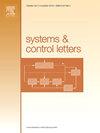弯矩反馈下欧拉-伯努利梁指数稳定性的均匀近似
IF 2.5
3区 计算机科学
Q3 AUTOMATION & CONTROL SYSTEMS
引用次数: 0
摘要
用常微分方程描述的无穷多个系统来均匀逼近由偏微分方程描述的无穷维系统,对于其在工程中的应用至关重要。本文研究了具有弯矩反馈的一维欧拉-伯努利梁的半离散格式的均匀指数稳定性,这与涉及剪力反馈控制的情况形成鲜明对比。几十年来,建立这种连续PDE的指数稳定性提出了一个重大挑战,主要是由于缺乏适当的时域乘法器。在某种程度上,这一障碍刺激了20世纪80年代频域乘数法的发展。值得注意的是,这里使用的频率乘法器是有关变实数和空间变量的指定指数函数,与最近对Schrödinger方程的研究不同。因此,半离散格式的一致稳定性问题在很长一段时间内仍未得到解决。本文首先利用频域方法建立了连续系统的指数稳定性。随后,我们采用降阶技术设计了该连续系统的空间半离散有限差分格式。最后,为了证明所得到的半离散系统的一致指数稳定性,我们采用离散频域方法,其证明方法与连续系统的证明方法相似。本文提出的方法有效地解决了涉及变化实数和空间变量的特定指数函数,具有应用于遇到类似挑战的其他偏微分方程的潜力。本文章由计算机程序翻译,如有差异,请以英文原文为准。
Uniform approximation of exponential stability for an Euler–Bernoulli beam under bending moment feedback
Uniformly approximating infinite-dimensional systems, such as those described by partial differential equations (PDEs), using infinitely many systems described by ordinary differential equations is crucial for their application in engineering. This paper examines uniform exponential stability for a semi-discrete scheme applied to a one-dimensional Euler–Bernoulli beam with bending moment feedback, which is sharp contrast to scenarios involving shear force feedback control. For decades, establishing the exponential stability of this continuous PDE has posed a significant challenge, primarily due to the absence of an appropriate time domain multiplier. This obstacle, in a way, spurred the advancement of the frequency domain multiplier method in the 1980s. Notably, the frequency multiplier utilized here is a specified exponential function of both concerned varying real numbers and spacial variable, distinguishing it from recent studies on the Schrödinger equation. Consequently, the question of uniform stability for the semi-discrete scheme has remained unresolved for an extended period. In this paper, we first establish the exponential stability of the continuous system using the frequency domain method. Subsequently, we employ an order-reduction technique to devise a spatially semi-discretized finite difference scheme for this continuous system. Ultimately, to demonstrate the uniformly exponential stability of the resulting semi-discretized system, we adopt the discrete frequency domain method, with the proof mirroring the approach used for the continuous system. The approach presented in this paper, which effectively addresses the specified exponential function involving both concerned varying real numbers and spatial variables, holds potential for application to other PDEs that encounter analogous challenges.
求助全文
通过发布文献求助,成功后即可免费获取论文全文。
去求助
来源期刊

Systems & Control Letters
工程技术-运筹学与管理科学
CiteScore
4.60
自引率
3.80%
发文量
144
审稿时长
6 months
期刊介绍:
Founded in 1981 by two of the pre-eminent control theorists, Roger Brockett and Jan Willems, Systems & Control Letters is one of the leading journals in the field of control theory. The aim of the journal is to allow dissemination of relatively concise but highly original contributions whose high initial quality enables a relatively rapid review process. All aspects of the fields of systems and control are covered, especially mathematically-oriented and theoretical papers that have a clear relevance to engineering, physical and biological sciences, and even economics. Application-oriented papers with sophisticated and rigorous mathematical elements are also welcome.
 求助内容:
求助内容: 应助结果提醒方式:
应助结果提醒方式:


